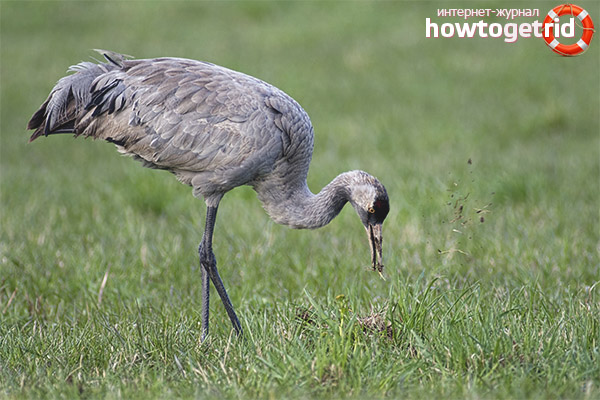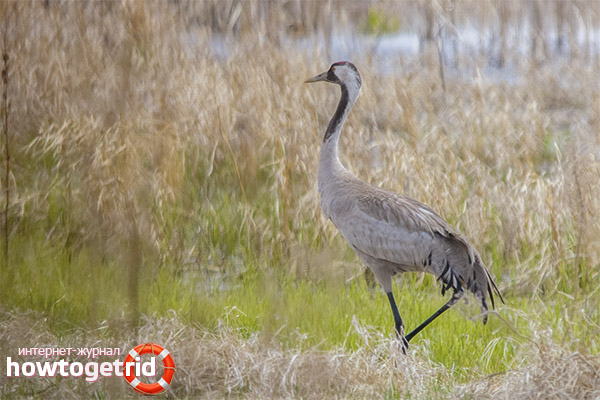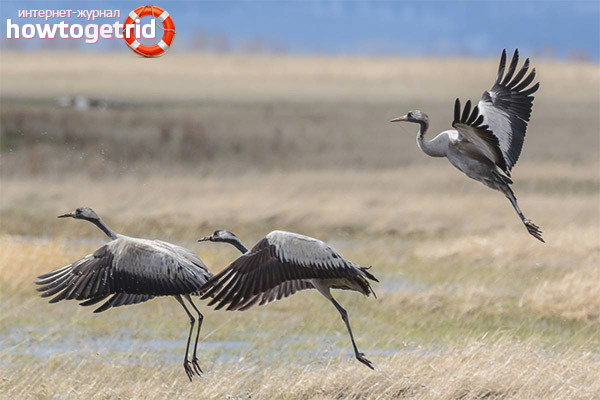The content of the article
The gray crane (Latin name “grus grus”, English - “grane”) is a beautiful and interesting bird. She often becomes the hero of folk tales, presenting herself to the reader as a smart animal. In many countries cranes are revered as sacred animals.
Species classification
- Kingdom: animals.
- Type: chordates.
- Class: Birds.
- Order: crane-like.
- Family: crane.
- Rod: cranes.
- Species: gray crane.
Description
The female and male have no cardinal differences in appearance. Height is about 115 cm, the length of the beak is 25-30 cm. The weight of the male individual can reach 6 kg, female - a little less. The wingspan is about 2 meters.
The color is gray, only in places black or white feathers are visible (on the sides and neck). Paws are black. White plumage on the cheeks. Feathers are completely absent on the dark. In young birds, feathers are gray with red tones. The main distinguishing feature is the red feathers on the head, similar to a hat.
In addition to the fact that the gray plumage looks very beautiful, this color masks well from predators.
Breeding
Birds should choose a place to nest. They like areas near water or thickets near water bodies. The male and female are looking for the right place, and after choosing they give a signal with a long cry. With the same exclamation, cranes warn of danger.
In May, the female lays eggs (from 1 to 3). Hatching takes 31 days. Female and male succeed each other in hatching eggs. After the hatching of the chicks, the parents equally care for them. Initially, the chicks are covered with down, and feathers on the wings and torso appear only at 3 months of life.
When the chicks get stronger, adult birds teach them to fly and search for food. Already in July they are able to fly independently. At the end of the month, the family leaves the nest and again leads a resettlement lifestyle. In early autumn, cranes gather in flocks to fly to warmer climes. At this stage, the independent life of the chicks begins.
Lifestyle
A feature that attracts many is that they tend to find their pair for the rest of their lives. An exception may be the death of one of the partners, as well as unsuccessful attempts to have offspring.
The male attracts female attention with funny dances and exclamations. This behavior can be with complete loneliness. During this period, the birds are very alert and shy.
Most often, gray cranes lead a nomadic lifestyle. They equip nests only for breeding.
Cranes nest at a far distance from other birds. They build large (meter in diameter) and sloppy nests from brushwood. Housing is being built very quickly. Dry grass is placed inside it.
Habitat
The crane prefers to live in the open, for example, a grass swamp. During hatching and caring for chicks, they settle near ponds or in thickets
Food
Cranes are not picky in food. Their diet includes a large number of plant foods: wild berries, seeds, plant shoots, crops (wheat, oats). In summer, birds feed on frogs and insects. They also eat small rodents (e.g. mice), snakes, lizards.
An important part of the crane diet is water. These birds consume a lot of fluids.If there is no water source nearby, cranes fly to other places several times a day.
In aviaries and nurseries, the diet of cranes is very diverse. They are given grain grains, raw meat, fish, etc. Cranes are very fond of compound feed intended for domestic chickens.
Abundance and prevalence
To date, the number of cranes is approximately 250 thousand birds. They live mainly in Russia and Scandinavia. The number of this species is constantly decreasing due to the drying of swamps and the construction of agricultural land. Farmers play a big role: they pesticide process fields where cranes seek food. Oddly enough, poachers have little effect on the number of cranes. People very rarely shoot these birds.
The gray crane is listed in the Red Book. The shooting and catching of birds is prohibited by law. Aviaries and nurseries are created to maintain numbers.
In Russia, there are 2 subspecies of the gray crane: eastern and western. By signs, they are practically no different. The dividing border passes through the Ural ridge. The western gray crane overwinters in African countries, and the eastern one in the northern parts of India and China. Some representatives of the species winter in the Caucasus.
Interesting Facts
- When cranes hatch eggs and look after chicks, they smear their plumage with silt or swamp mud. This is done for good camouflage and protection against predatory animals.
- The take-off of the crane is a bewitching sight. It runs smoothly and spreads its wings just before takeoff.
- The crane is the oldest animal. This representative of the family of birds appeared about 40-60 million years ago. This means that the crane caught the dinosaur era. Primitive people depicted these birds on the walls of caves and rocks.
- Cranes are highly revered in many countries. For example, in Armenia, this bird is a symbol of the country. Cranes often appear in folk tales and stories.
- The life expectancy of cranes is 20 years. However, birds can live in the nursery for 80 years, which is a great age for birds.
- Indoor flower geranium got its name in honor of the crane (in Latin the word "crane" is written and pronounced "grus grus").
- By the number of individuals, the gray crane ranks second among crane species.
- Adults molt every year, which is why some birds are temporarily unable to fly.
- The closest relative is the Demoiselle Crane.
Video: gray crane (Grus communis)












Submit